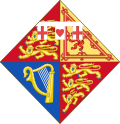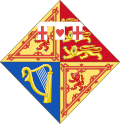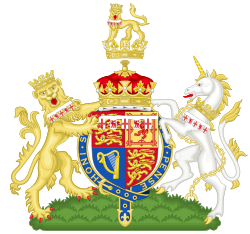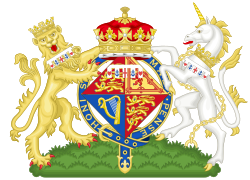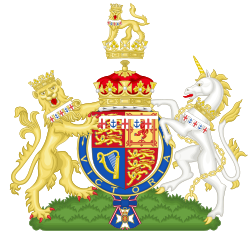| Coat of arms of the United Kingdom | |
|---|---|
 | |
| Versions | |
 | |
| Armiger | Monarch of the United Kingdom |
| Adopted | 1837 |
| Crest | Upon the helm, the imperial crown proper thereon a lion statant guardant Or langued Gules armed Argent, imperially crowned Proper; mantled Or doubled Ermine (Scottish version)
|
| Shield | Quarterly, I and IV Gules, three lions passant guardant in pale Or langued and armed Azure. II Or a lion rampant Gules armed and langued Azure within a double tressure flory-counter-flory Gules. III Azure a harp Or stringed Argent. (Scottish version)
|
| Supporters | On the dexter a lion rampant guardant Or langued and armed Gules, imperially crowned Proper. On the sinister a Unicorn rampant Argent armed crined and unguled Or, and gorged with a Coronet composed of crosses patee and fleurs-de-lis, a chain affixed thereto passing through the forelegs and reflexed over the back Or (Scottish version)
|
| Compartment | Tudor rose, Shamrock, Thistle (Scottish version)
|
| Motto | Dieu et mon droit (Scottish version)
|
| Order | Order of the Garter (Scottish version)
|
| Earlier version | See below |
The coat of arms of the United Kingdom, also referred to as the royal arms, are the arms of dominion of the British monarch, currently Charles III. [1] They are used by the Government of the United Kingdom and by other Crown institutions, [2] including courts in the United Kingdom and in some parts of the Commonwealth. Differenced versions of the arms are used by members of the British royal family. The monarch's official flag, the royal standard, is the coat of arms in flag form.
Contents
- Description
- Outside Scotland
- In Scotland
- Blazon
- History
- Arms of England, Scotland and Ireland
- Great Britain
- United Kingdom
- Usage
- Restrictions
- UK usage
- Commonwealth usage
- Royal family
- See also
- Notes
- References
- External links
There are two versions of the coat of arms. One is used in Scotland, and includes elements derived from the coat of arms of the Kingdom of Scotland, and the other is used elsewhere and includes elements derived from the coat of arms of the Kingdom of England. The shields of both versions of the arms quarter the arms of the kingdoms of England and Scotland, which united to form the Kingdom of Great Britain in 1707, and the Kingdom of Ireland, which united with Great Britain to form the United Kingdom in 1801. The Irish quarter was unaltered following the division of Ireland into Northern Ireland and the Irish Free State in 1922.
The present arms do not include a representation of the United Kingdom's fourth constituent country, Wales. [3] It is instead represented heraldically by two royal badges, which use the Welsh dragon and the coat of arms of Llywelyn ab Iorwerth respectively.






















